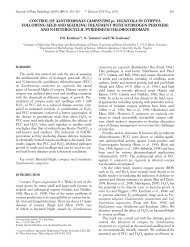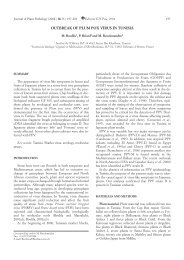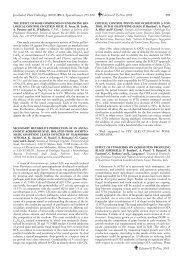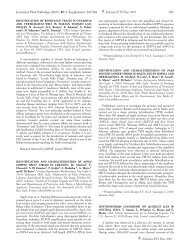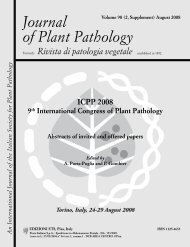Journal of Plant Pathology (2010), 92 (4, Supplement ... - Sipav.org
Journal of Plant Pathology (2010), 92 (4, Supplement ... - Sipav.org
Journal of Plant Pathology (2010), 92 (4, Supplement ... - Sipav.org
You also want an ePaper? Increase the reach of your titles
YUMPU automatically turns print PDFs into web optimized ePapers that Google loves.
<strong>Journal</strong> <strong>of</strong> <strong>Plant</strong> <strong>Pathology</strong> (<strong>2010</strong>), <strong>92</strong> (4, <strong>Supplement</strong>), S4.71-S4.105 S4.89<br />
SHOOT AND TIP BLIGHT BY DIPLODIA PINEA AND D.<br />
SCROBICULATA DETECTED BY MOLECULAR METH-<br />
ODS ON PSEUDOTSUGA MENZIESII IN CENTRAL<br />
ITALY. V. Mancini, N. Luchi, P. Capretti. Dipartimento di Biotecnologie<br />
Agrarie, Sezione di Protezione delle Piante, Università<br />
degli Studi, Piazzale delle Cascine 28, 50144 Firenze, Italy. E-mail:<br />
vale.mancini@yahoo.it<br />
The occurrence <strong>of</strong> Diplodia pinea as the causal agent <strong>of</strong> tip<br />
and shoot blight has <strong>of</strong>ten been reported from Pinus spp. and<br />
other conifers. In Italy, D. pinea is quite frequent on pines but also<br />
D. scrobiculata has occasionally been found on different hosts<br />
species in Sardinia and other localities <strong>of</strong> southern Italy. Recently<br />
in Tuscany (central Italy) during the annual regional monitoring<br />
survey (META http://meta.arsia.toscana.it/ ) symptoms <strong>of</strong> crown<br />
disease were observed in Douglas fir (Pseudotsuga menziesii)<br />
stands. The disease was especially frequent in the lower part <strong>of</strong><br />
the crowns <strong>of</strong> 20- to 40-year-old trees. Terminal shoots and small<br />
branches were completely defoliated, the bark was necrotic and<br />
showed sporadic black picnidia. In the last few years a fungus<br />
was isolated from branches and shoots. Single spore colonies<br />
were obtained, grown in pure culture and DNA was extracted.<br />
Diplodia was identified on the basis <strong>of</strong> both morphological (fungal<br />
structures and colonies) and molecular methods. DNA amplification<br />
assays using specific primers available in the literature<br />
confirmed the identification <strong>of</strong> the fungal species as D. pinea in<br />
most <strong>of</strong> the samples but revealed also the occurrence <strong>of</strong> D. scrobiculata<br />
in some <strong>of</strong> the Douglas fir trees.<br />
DIPLODIA PINEA DETECTION ON LEPTOGLOSSUS OC-<br />
CIDENTALIS (INSECT VECTOR) BY REAL TIME-PCR. V.<br />
Mancini, N. Luchi, M. Feducci, P. Capretti. Dipartimento di<br />
Biotecnologie Agrarie, Sezione di Protezione delle Piante, Università<br />
degli Studi, Piazzale delle Cascine 28, 50144 Firenze, Italy.<br />
E-mail: vale.mancini@yahoo.it<br />
Leptoglossus occidentalis (Hemiptera: Coreidae), an insect native<br />
to North America, is present in Italy since 1999. It now occurs<br />
mainly in Pinus pinea stands where it is thought to cause extensive<br />
damage to seed production. Considering that this insect<br />
has the same habitat (cones <strong>of</strong> conifers) <strong>of</strong> Diplodia pinea, a fungus<br />
responsible for damaging pine cones, it is possible that it may<br />
be involved in spreading fungal conidia. Real time PCR was used<br />
for detecting and quantify fungal DNA on both cones and L. occidentalis<br />
bodies. Materials for PCR assays were symptomless 1year-old<br />
cones collected in S. Rossore (Pisa), individuals <strong>of</strong> L. occidentalis<br />
sampled in a conifer forest (Vallombrosa, Florence) and<br />
insectes reared in the laboratory. Some <strong>of</strong> the latter were washed<br />
with a conidial suspension <strong>of</strong> D. pinea, others were placed in a<br />
cage and allowed to walk on pine cones infected by D. pinea and<br />
still others, coming directly from breeding colonies, served as<br />
negative control. DNA was extracted from all samples (cones, insects<br />
and insects’ washing waters) and PCR was carried out using<br />
fungus-specific primers. D. pinea was detected on all cones<br />
analysed and, frequently, on L. occidentalis bodies This is taken as<br />
an indication that L. occidentalis may have a role as possible vector<br />
<strong>of</strong> D. pinea.<br />
INTERACTION OF CERATO-PLATANIN AND CERATO-<br />
POPULIN WITH INANIMATE AND PLANE LEAF SUR-<br />
FACES: A STRUCTURAL STUDY. F. Martellini 1 , L. Pazzagli 1 ,<br />
L. Carresi 2 , F. Sbrana 3 , B. Tiribilli 4 , B. Pantera 1 , G. Cappugi 1 , F.<br />
Faoro 5 , A. Scala 2 . 1 Dipartimento di Scienze Biochimiche, Univer-<br />
sità degli Studi, Viale M<strong>org</strong>agni 50, 50134 Firenze, Italy. 2 Dipartimento<br />
di Biotecnologie Agrarie, Sezione di Protezione delle Piante,<br />
Laboratorio di Patologia Vegetale Molecolare, Università degli Studi,<br />
Via della Lastruccia 10, 50019 Sesto Fiorentino (FI), Italy. 3 Dipartimento<br />
di Ingegneria Bi<strong>of</strong>isica ed Elettronica, Università degli<br />
Studi, Via Opera Pia 11A, 16145 Genova, Italy. 4 Istituto dei Sistemi<br />
Complessi del CNR, Via Madonna del Piano 10, 50019 Sesto<br />
Fiorentino (FI), Italy. 5 Dipartimento di Produzione Vegetale, Università<br />
degli Studi, Via Celoria 2, 20133 Milano, Italy. E-mail:<br />
federica.martellini@unifi.it<br />
Cerato-platanin (CP) and cerato-populin (Pop1) are proteins<br />
abundantly secreted by and localized in the cell wall <strong>of</strong> Ceratocystis<br />
platani and C. populicola, respectively. Both are assumed to<br />
play a role in plant interaction, since they induce accumulation <strong>of</strong><br />
H 2 O 2 and NO, programmed plant cell death, overexpression <strong>of</strong><br />
defence genes, phytoalexin synthesis and restriction <strong>of</strong> conidia<br />
growth. Thus, CP and Pop1 appear to act as PAMPs able to activate<br />
effective primary defence systems. CP and Pop1 are members<br />
<strong>of</strong> the “cerato-platanin family” containing proteins involved<br />
in many microbe-host interactions acting as phytotoxins, elicitors<br />
<strong>of</strong> defence responses or human allergens. Cellular localization in<br />
fungi suggests a role <strong>of</strong> these proteins in interaction with host<br />
surfaces. To investigate the mechanism <strong>of</strong> interaction, in vitro and<br />
in vivo experiments have been performed. CP and Pop1 strongly<br />
interacted with Teflon, a colloidal suspension used to mimic hydrophobic<br />
surfaces. During reaction, these proteins lost their native<br />
structure and adopted an unfolding conformation with a<br />
small percentage <strong>of</strong> α-helix. Moreover, CP and Pop1 were adsorbed<br />
on hydrophobic surfaces (silanized mica, gold sheets and<br />
graphite) and appeared as supra-molecular aggregates, which resemble<br />
the ordered assemblages that the proteins form in vitro,<br />
and are able to enhance host-defences. In vivo, the proteins<br />
seemed to interact with the hydrophobic cuticle <strong>of</strong> the plane<br />
leaves and did not penetrate the cell wall and the membrane. The<br />
results suggest that CP and Pop1 interact with hydrophobic components<br />
<strong>of</strong> the host before inducing defence events.<br />
ANTIFUNGAL ACTIVITY OF TERPENES IDENTIFIED<br />
IN THE LEAVES OF ROSMARINUS OFFICINALIS. V. Martini<br />
1,2 , C. Comparini 2 , P. Capretti 2 , M. Michelozzi 1 , A. Scala 2 .<br />
1 Dipartimento di Biotecnologie Agrarie, Sezione di Protezione delle<br />
Piante, Università degli Studi, Piazzale delle Cascine 28, 50019 Sesto<br />
Fiorentino (FI), Italy. 2 Istituto di Genetica Vegetale del CNR, Via<br />
Madonna del Piano, 50019 Sesto Fiorentino (FI), Italy. E-mail:<br />
martini@imgpf.fi.cnr.it<br />
<strong>Plant</strong>s <strong>of</strong> Rosmarinus <strong>of</strong>ficinalis are widely distributed in Europe,<br />
Asia and Africa. Mediterranean is the area where spontaneous<br />
plants are commonly found. This plant is known for its use<br />
in cookery, and the increasing interest for its pharmaceutical<br />
properties. Two groups <strong>of</strong> compounds are mainly responsible <strong>of</strong><br />
the biological activities <strong>of</strong> rosemary: the volatile fraction and the<br />
phenolic constituents. Alternaria leaf spot <strong>of</strong> rosemary has been<br />
reported in various Italian regions, as the cause <strong>of</strong> black spots on<br />
leaves and stems followed by defoliation. The aim <strong>of</strong> the present<br />
work was to investigate the antifungal activity <strong>of</strong> different rosemary<br />
monoterpenes against a strain <strong>of</strong> Alternaria alternata (Fr.)<br />
Keissl. recently isolated from an Alternaria-diseased rosemary<br />
plant. Their antifungal activity was evaluated as inhibition <strong>of</strong> the<br />
mycelial growth using “special vials” containing potato dextrose<br />
broth and increasing concentrations (0.025, 0.1, 0.4, 1.6, 6.4, 10.0<br />
and 100 mM) <strong>of</strong> 1,8-cineole, (+)-alpha-pinene, (-)-alpha-pinene,<br />
(+)-limonene, (-)-limonene, (-)-beta-pinene, (+)-beta-pinene,<br />
myrcene and linalool. The minimum inhibitory concentration



